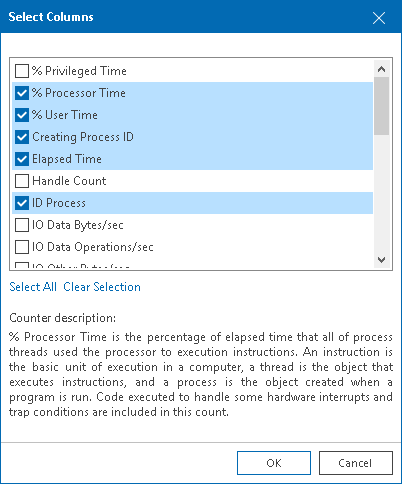VMware vSphere In-Guest Processes
You can view and control processes currently running inside a VM or vCenter Server.
- For Windows-based machines, you can view, end or restart processes.
- For Linux-based machines, you can view or end daemons.
Prerequisites
Before viewing in-guest processes, check the following prerequisites:
- Make sure that VMware Tools are installed.
- For Linux-based machines, make sure that the SSH Server is started.
- For Windows based machines make sure:
- The Remote Registry service is Enabled and Started.
- The Local Policy Always wait for the network at computer startup and logon is enabled.
- Make sure that the fully qualified domain name (FQDN) can be resolved by the Veeam ONE server.
Viewing In-Guest Processes
To view the list of processes:
- Open Veeam ONE Client.
For details, see Accessing Veeam ONE Components.
- At the bottom of the inventory pane, click Virtual Infrastructure.
- In the inventory pane, select the necessary infrastructure object.
- Open the Guest OS tab and navigate to Processes.
- Provide OS authentication credentials (user name and password) to access the list of running processes.
Every process is described with a set of counters that are presented as column headings. You can add or remove counters to monitor running processes:
- In the upper right corner of the Processes dashboard, click the Select Columns link.
- In the Select Columns window, select check boxes next to counters you want to display.
- To view the detailed description of a counter, click it in the Counters list. The description will be displayed in the lower pane of the window.
You can end unwanted processes running on the VM or create an alarm based on the process state or object performance:
- [For Windows-based machines] To end a process, select it in the list and click the Kill Process button, or right-click a necessary process and select Kill Process from the shortcut menu.
- [For Linux-based machines] To end a daemon, select it in the list and click the Kill Process button and choose one of the following options:
- Hangup — to send the SIGHUP signal
- Kill — to send the SIGKILL signal
- Terminate — to send the SIGTERM signal
You can also right-click a necessary process and select Kill Process and choose the necessary option from the shortcut menu.
- [For Windows-based machines] To create an alarm, select one or more processes in the list, click the Create Alarm button, and select the type of rule on which the alarm must be based. For details on alarm rules, see Alarm Rules.
